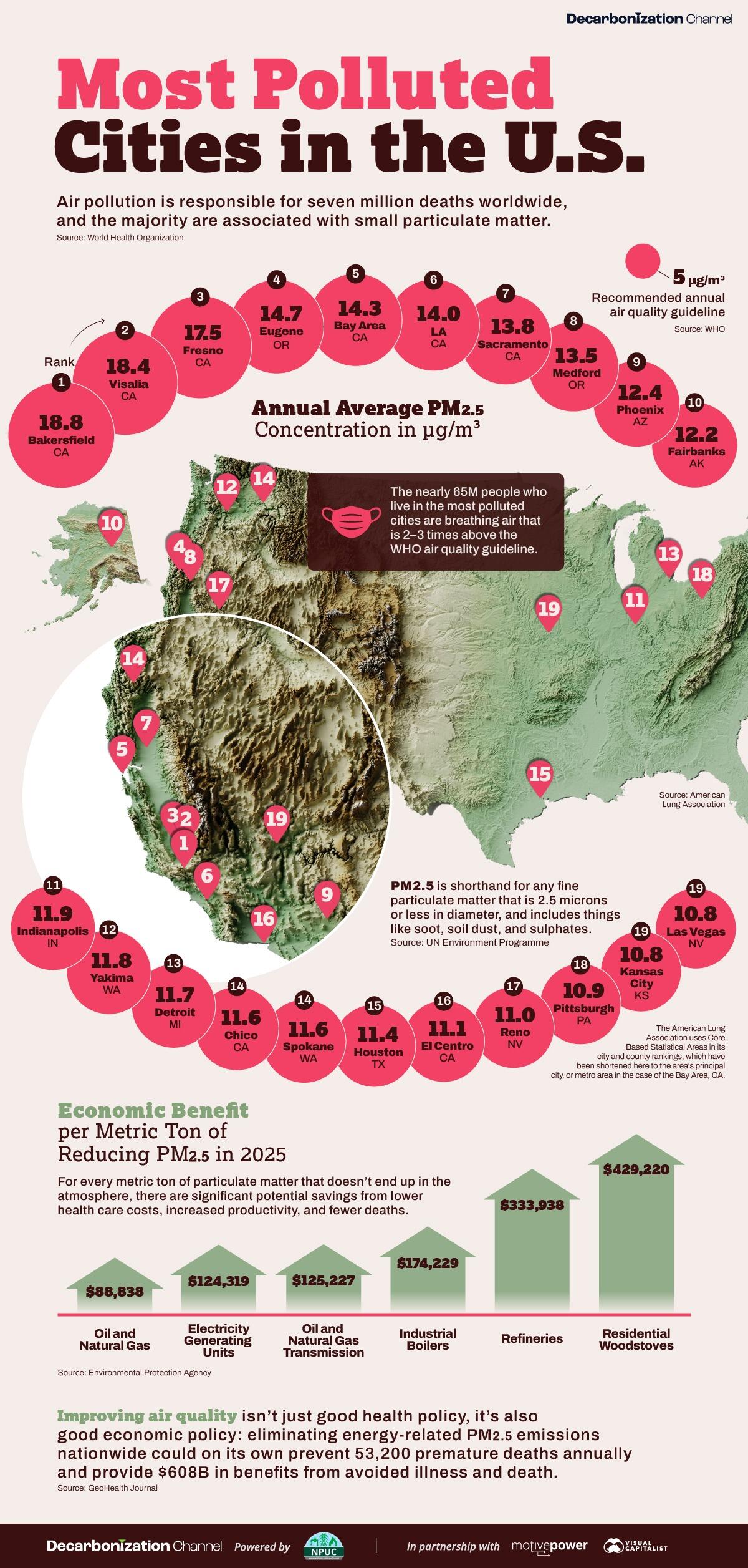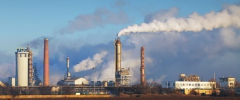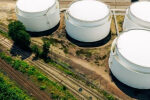- Six of the top seven most polluted cities in the US are located in California.
- The Central Valley in California experiences trapped pollution due to its geographical features.
- Air pollution causes millions of deaths annually and has significant economic impacts.
According to the World Health Organization, air pollution is responsible for 7 million deaths annually, and could cost the global economy between $18–25 trillion by 2060 in annual welfare costs, or roughly 4–6% of world GDP.
And with predictions that 7 in 10 people will make their homes in urban centers by mid-century, cities are fast becoming one of the frontlines in the global effort to clear the air.
In this visualization, Visual Capitalist’s Chris Dickert uses 2024 data from the State of the Air report from the American Lung Association to show the most polluted cities in the United States.

What is Air Pollution?
Air pollution is a complex mixture of gases, particles, and liquid droplets and can have a variety of sources, including wildfires and cookstoves in rural areas, and road dust and diesel exhaust in cities.
There are a few kinds of air pollution that are especially bad for human health, including ozone and carbon monoxide, but here we’re concerned with fine particulate matter that is smaller than 2.5 microns, or PM2.5 for short.
The reason for the focus is because at that small size, particulate matter can penetrate the bloodstream and cause all manner of havoc, including cardiovascular disease, lung cancer, and chronic pulmonary disease.
The American Lung Association has set an annual average guideline of 9 µg/m³ for PM2.5, however, the World Health Organization has set a much more stringent limit of 5 µg/m³.
The 21 Worst Polluted Cities in the U.S.
Here are the top 21 most polluted cities in the U.S., according to their annual average PM2.5 concentrations:
|
Rank |
City, State |
Annual average concentration, 2020-2022 (µg/m3) |
|
1 |
Bakersfield, CA |
18.8 |
|
2 |
Visalia, CA |
18.4 |
|
3 |
Fresno, CA |
17.5 |
|
4 |
Eugene, OR |
14.7 |
|
5 |
Bay Area, CA |
14.3 |
|
6 |
Los Angeles, CA |
14.0 |
|
7 |
Sacramento, CA |
13.8 |
|
8 |
Medford, OR |
13.5 |
|
9 |
Pheonix, AZ |
12.4 |
|
10 |
Fairbanks, AK |
12.2 |
|
11 |
Indianapolis, IN |
11.9 |
|
12 |
Yakima, WA |
11.8 |
|
13 |
Detroit, MI |
11.7 |
|
T14 |
Chico, CA |
11.6 |
|
T14 |
Spokane, WA |
11.6 |
|
15 |
Houston, TX |
11.4 |
|
16 |
El Centro, CA |
11.1 |
|
17 |
Reno, NV |
11.0 |
|
18 |
Pittsburgh, PA |
10.9 |
|
T19 ADVERTISEMENT |
Kansas City, KS |
10.8 |
|
T19 |
Las Vegas, NV |
10.8 |
Note: The American Lung Association uses Core Based Statistical Areas in its city and county rankings, which have been shortened here to the area’s principal city, or metro area in the case of the Bay Area, CA.
Six of the top seven cities are in California, and four in the state’s Central Valley, a 450-mile flat valley that runs parallel to the Pacific coast, and bordered by the Coast and Sierra Nevada mountain ranges. As a result, when pollution from the big population centers on the coast is carried inland by the wind—cities #5 and #6 on the list—it tends to get trapped in the valley.
Bakersfield (#1), Visalia (#2), and Fresno (#3) are located at the drier and hotter southern end of the valley, which is worse for air quality. The top three local sources of PM2.5 emissions in 2023 were farms (20%), forest management / agricultural waste burning (20%), and road dust (14%).
Benefit to Economy
While the health impacts are generally well understood, less well known are the economic impacts.
Low air quality negatively affects worker productivity, increases absenteeism, and adds both direct and indirect health care costs. But the flip side of that equation is that improving air quality has measurable impacts to the wider economy. The EPA published a study that calculated the economic benefits of each metric ton of particulate matter that didn’t end up in the atmosphere, broken down by sector.
|
Sector |
Benefits per metric ton |
|
Residential Woodstoves |
$429,220 |
|
Refineries |
$333,938 |
|
Industrial Boilers |
$174,229 |
|
Oil and Natural Gas Transmission |
$125,227 |
|
Electricity Generating Units |
$124,319 |
|
Oil and Natural Gas |
$88,838 |
At the same time, the EPA recently updated a cost-benefit analysis of the Clean Air Act, the main piece of federal legislation governing air quality, and foun





